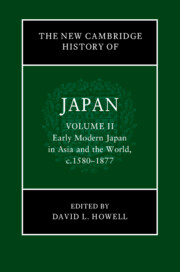Book contents
- The New Cambridge History of Japan
- The New Cambridge History of Japan
- The New Cambridge History of Japan
- Copyright page
- Contents
- Figures
- Maps
- Tables
- Contributors to Volume II
- Preface
- Frontispiece
- Introduction
- Part I The Character of the Early Modern State
- 1 The End of Civil War and the Formation of the Early Modern State in Japan
- 2 Politics and Political Thought in the Mature Early Modern State in Japan, 1650–1830
- 3 Regional Authority during the Tokugawa Period
- 4 Tokugawa Philosophy
- 5 Foreign Relations and Coastal Defense under the Mature Tokugawa Regime
- 6 The Meiji Restoration
- PART II Economy, Environment, and Technology
- Part III Social Practices and Cultures of Early Modern Japan
- Index
- References
3 - Regional Authority during the Tokugawa Period
from Part I - The Character of the Early Modern State
Published online by Cambridge University Press: 15 January 2024
- The New Cambridge History of Japan
- The New Cambridge History of Japan
- The New Cambridge History of Japan
- Copyright page
- Contents
- Figures
- Maps
- Tables
- Contributors to Volume II
- Preface
- Frontispiece
- Introduction
- Part I The Character of the Early Modern State
- 1 The End of Civil War and the Formation of the Early Modern State in Japan
- 2 Politics and Political Thought in the Mature Early Modern State in Japan, 1650–1830
- 3 Regional Authority during the Tokugawa Period
- 4 Tokugawa Philosophy
- 5 Foreign Relations and Coastal Defense under the Mature Tokugawa Regime
- 6 The Meiji Restoration
- PART II Economy, Environment, and Technology
- Part III Social Practices and Cultures of Early Modern Japan
- Index
- References
Summary
This chapter examines the structure of regional authority in early modern Japan. Its aim is to clarify the nature of the early modern Japanese state. The shogunate delegated authority to autonomous daimyo domains, and both shogunate and domains delegated authority to village heads, who managed their communities with little direct oversight. The system worked well enough to keep the realm generally peaceful and prosperous for 265 years. The chapter begins with a top-down taxonomy of the daimyo domains and other, lesser jurisdictions under the authority of the Tokugawa shogunate. It then moves onto a discussion of village rule, framed in terms of governmentality – that is, the structures through which villagers participated in their own subjecthood to the shogunate and domains. The chapter concludes with a discussion of shared-revenue villages (aikyū mura), which were divided among multiple overlords while retaining a character as singular communities.
Keywords
- Type
- Chapter
- Information
- The New Cambridge History of Japan , pp. 97 - 127Publisher: Cambridge University PressPrint publication year: 2023



